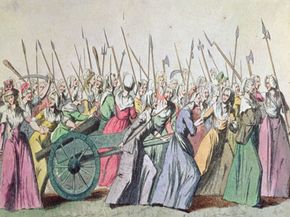The Trouble with Traitors: French Revolution Events
On Oct. 5, 1789, an agitated assembly of women demanding bread marched to Versailles. They surged effortlessly past the palace guards and thundered into the queen's bedroom mere minutes after she fled. The mob wanted the royal family to come with them to Paris, and the ever-faltering Louis at last acquiesced to the people's demands. With a heavy heart, he added his signature to the Declaration of the Rights of Man and loaded his family into the royal carriage. As they rolled somberly alongside the crowd, the heads of their dead guards bobbed mockingly beside their windows.
But Louis wouldn't be content as puppet king for very long. Even though he was imprisoned by the people in the Tuileries Palace, he had allies beyond France's borders who wanted to see him regain the throne.
Advertisement
As the events of the French Revolution slowly unfolded, the rest of the world had been watching guardedly from a distance. Britain and other European nations were delighted to watch the superpower implode, but they'd later be horrified at the escalating bloodiness of the revolution. Americans were a degree more sympathetic; France had largely funded their revolution. One difference between the nations was that the United States had emerged as a republic (a government in which the power lies in the people's hands and popular vote decides the leaders), and France was still a constitutional monarchy (a limited monarchy in which the king or queen is limited in legislative powers).
As prisoner of the people in the Tuileries, Louis was surrounded by all the revolutionary action in Paris. The National Assembly had followed suit behind the king, shifting their headquarters from Versailles to Paris. The city was veritably bursting with the spirit of change. And for at least two years, the degenerating monarchy cooperated with the National Assembly. Louis signed the new government's legislative policies while Marie Antoinette looked on in disbelief.

With her family members reigning as active monarchs in neighboring Austria, she saw no reason that Louis should relinquish control to bloodthirsty peasants. At last, she won her husband over. (For more on Marie Antoinette's perspectives, read Top 5 Marie Antoinette Scandals.) They planned an escape and broke from the Tuileries on the night of June 21, 1791, under the guise of servants. The royal family was close to the Austrian border when its carriage was apprehended at the town of Varennes.
When Louis and his family were brought back to their quarters at the Tuileries, they were kept under heavier watch. At this point, even the king's sympathizers could no longer feel affection for the monarch -- in France's darkest hour, he'd scurried away like a rat in the night. The French people began to suspect that Marie Antoinette's connections in Austria might be planning to wage war against them, so under the booming recommendation of Jacques Pierre Brissot, the National Assembly declared war on both Austria and Prussia in April 1792.
Suspicions against the royal family continued to mount, including founded or unfounded beliefs that Marie Antoinette was writing to her family about confidential military maneuvers. In an act of misguided duty to the monarchies of Europe, Prussia's Duke of Brunswick wrote that he would raze Paris to the ground if the king were harmed. The Parisian press printed the letter for the whole city to see, and an enraged mob stormed the Tuileries. Louis was made to go on trial as an ordinary citizen, and he was quickly proclaimed guilty.
The matter of what to do with a dethroned traitor effectively split the National Assembly in two.
